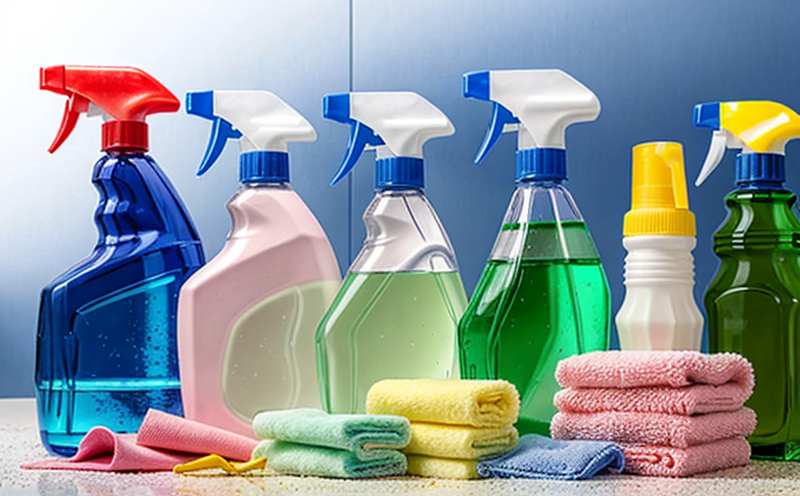Antibacterial Testing of Detergents (ISO 22196)
The Antibacterial Testing of Detergents according to ISO 22196 is a critical step in ensuring the efficacy and safety of cleaning products. This standardized test measures the antimicrobial activity of detergents against selected bacteria, which are significant causes of infections in hospitals as well as in household settings.
The process involves exposing the detergent sample to various concentrations of bacteria under controlled conditions. The effectiveness is then evaluated by determining how much bacterial growth is inhibited compared to a control sample that does not contain the tested detergent. This test ensures that cleaning products can effectively kill harmful microorganisms, thereby contributing to public health and hygiene.
The procedure adheres strictly to ISO 22196:2011 guidelines which outline specific protocols for both laboratory and field testing. Compliance with these standards is essential not only for product safety but also for regulatory compliance in different regions around the world.
Testing of detergents against bacteria like Staphylococcus aureus, Escherichia coli, and Pseudomonas aeruginosa provides robust evidence that supports claims made about a product's antibacterial properties. This information is invaluable to quality managers looking to ensure their products meet or exceed industry standards.
For R&D engineers working on new formulations, this test offers valuable insights into optimizing detergent formulas for enhanced microbial control without compromising other performance attributes. It also helps in identifying potential areas of improvement and ensuring that any changes made do not adversely affect the product's efficacy against targeted bacteria.
The results from such tests are crucial for compliance officers who need to ensure their products comply with local regulations regarding claims about antibacterial properties. By adhering strictly to ISO 22196, companies can demonstrate due diligence and avoid potential legal issues associated with misleading or unsubstantiated claims.
Why Choose This Test
The Antibacterial Testing of Detergents (ISO 22196) is an indispensable tool for manufacturers who aim to produce high-quality cleaning products that are effective in eliminating harmful bacteria. Here’s why this test should be a priority:
- Regulatory Compliance: Ensures adherence to international standards and local regulations.
- Consumer Trust: Builds confidence among consumers who demand safe and effective cleaning solutions.
- R&D Innovation: Provides data that can drive product improvements and innovations.
- Market Differentiation: Allows companies to position their products as superior in terms of microbial control.
- Patient Safety: Especially important for healthcare settings where cross-contamination is a concern.
- Ethical Responsibility: Demonstrates commitment to public health and safety.
By incorporating this test into their quality assurance processes, companies not only enhance the reliability of their products but also contribute positively towards maintaining hygienic standards across various industries.
International Acceptance and Recognition
- ISO 22196: Widely recognized as an international standard for measuring antibacterial efficacy of detergents.
- ASTM E2876: Complementary American test method that aligns closely with ISO standards, providing additional local market acceptance.
- EN 14995: European equivalent focusing on similar parameters but tailored to European regulatory environments.
- IEC 62768-3: Pertains specifically to the use of detergents in medical devices, ensuring they meet stringent hygiene requirements.
- AFNOR NF X30-150: Recognized by French authorities for its strict criteria on antibacterial activity.
- AAPL Guidelines: Adopted by the Association of American Pest Control Operators to ensure pest control products are safe and effective.
The widespread acceptance of ISO 22196 across these standards underscores its importance in maintaining consistent quality and performance expectations globally. Compliance with this standard ensures that detergents meet rigorous international benchmarks, facilitating smoother market entry into diverse jurisdictions.
Use Cases and Application Examples
| Use Case | Description |
|---|---|
| Hospital Hygiene | Detergents tested for antibacterial efficacy help prevent the spread of infections among patients and staff. |
| Food Processing Facilities | Absolutely necessary to ensure that all surfaces are free from pathogens, protecting food safety. |
| Homes & Offices | Effective cleaning products in households and offices reduce the risk of illness due to bacteria present in common areas. |
| Clinical Trials | Evaluating new formulations for their potential antibacterial properties before market release. |
| Disinfection Programs | A key component of comprehensive disinfection programs in public spaces and institutions. |
| Medical Device Manufacturing | Maintaining sterility during production to prevent contamination. |
The versatility of this test ensures its applicability across multiple sectors, making it a cornerstone for maintaining hygiene standards worldwide. Each use case highlights the critical role that antibacterial testing plays in enhancing safety and effectiveness within diverse environments.





